..................
.......................................--- Cooling the Kera Jane's Crew ---
On our western trips keeping cool on the boat wasn't a big problem. We encountered some 90+ deg. temps on our Idaho/Canada trip but the nights were cool and the humidity was low. Our Lake Powell trips were in the fall when the temps there again don't get over 90 and the humidity is even lower, usually below 20%. We also didn't do any cooling mods for the Fall 2010 trip to Florida, but when we went back in the spring the temps would be climbing along with the humidity. During the winter I made a couple small fans from computer fans that I'll talk about further down the page, but that was it.
When we were on the water in March in Florida it was pretty pleasant. Come April we knew that the temps would started to climb and we had planned on staying into May when it would be hotter yet. We had a West Marine catalog on the boat, so I started looking at fan options as the computer fans had their merits, cut weren't big air movers.
..........................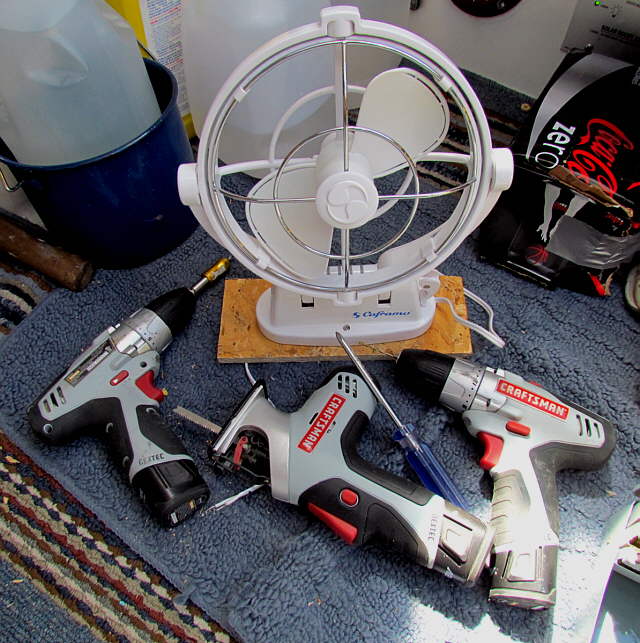
While we were anchored in Factory Bay at Marco Island waiting for a solar panel to replace the one I broke in an encounter with a piling at the fuel dock we walked down to the local West Marine store and looked at the fans they had. It was pretty nice as they had them hooked up and you could actually run them and compare the air movement. The one above was the one we settled on and of course it also proved to be one of the most expensive at $100. It seemed to put out the most air of any of the ones we tried and also it consumed about the least amperage.
..........................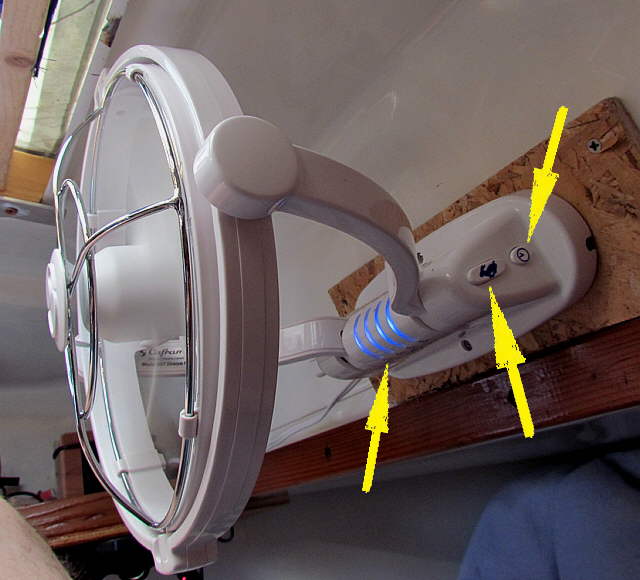
The fan has 3 speed settings that are set by the number of times you hit the 'bunny' button, middle arrow above. The amperage for the 3 settings is .21, .27, .34 amps or only 210 mA or 2.5 watts on low or 4 watts on high. That isn't much electricity. The good thing is that the fan moves a lot of air on low. In fact low is all we ever used. I did see that West Marine shows a lower amperage than the manufacture's amperage that I mentioned above.
The other nice feature the fan has is that it has 4 timers. 2 hr., 4 hr., 6 hr., and 8 hr. If you start the fan it goes to the 2 hr. automatically. Each time you push the timer button, right arrow, it adds another 2 hr. The lights on the front, left arrow, tell you which setting it is on. Above all 4 lights are lit, so it would run 8 hours and then turn off. We used this fan ....
..........................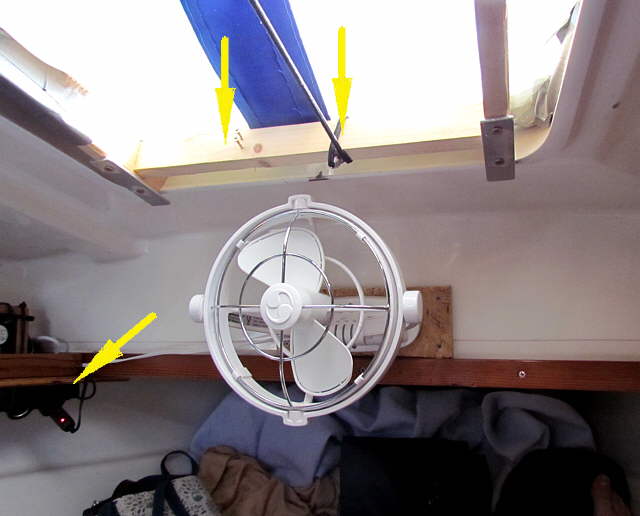
... to blow air on us coming down through the forward hatch. Our lower legs were ahead of the fan, but the fan on low would blow air coming down the hatch on both of our upper bodies. We would start it at night on low and with the timer set to 2 hours and go to sleep in comfort. It would then automatically turn off after 2 hours. If we woke up later or in the morning and wanted more air I just reached down and push the speed button once.
I put a cigarette 12 volt plug on the fan cord and plugged it into an outlet that I installed on the port side. We did all of this on the water with the 12 volt Craftsman tools in the first picture using some scrap wood that we carry on the boat for situations like this.
..........................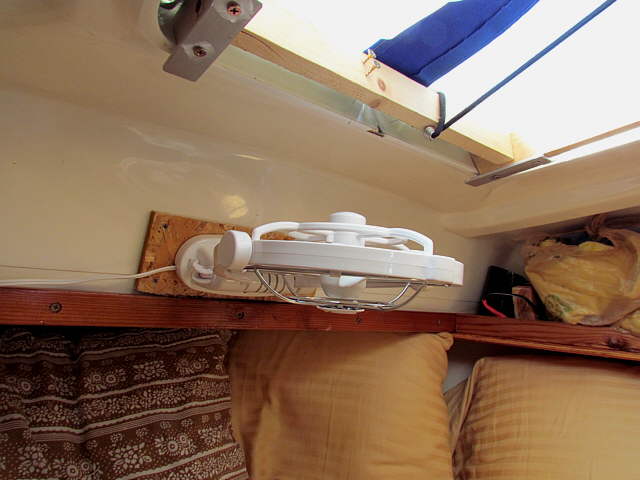
The final outstanding feature of this fan is that you can point it anywhere from any location. The whole fan head pivots on the base to different angles and the ....
..........................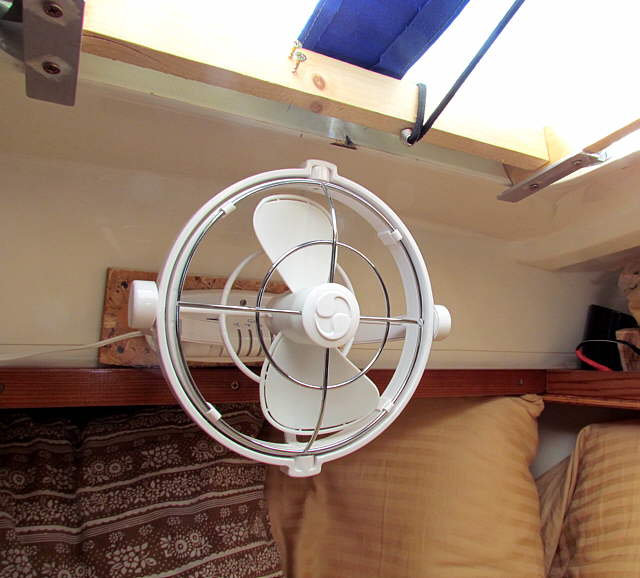
..the head is a full gimbaled design that lets you rotate it to any position...
..........................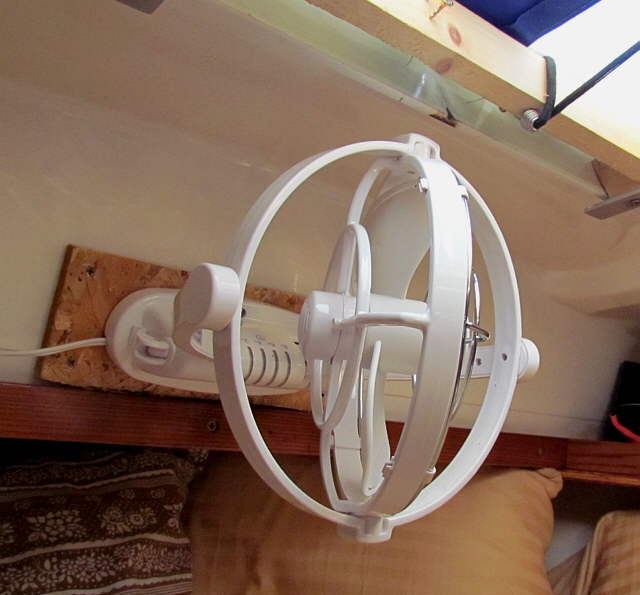
.... that you want to and.....
..........................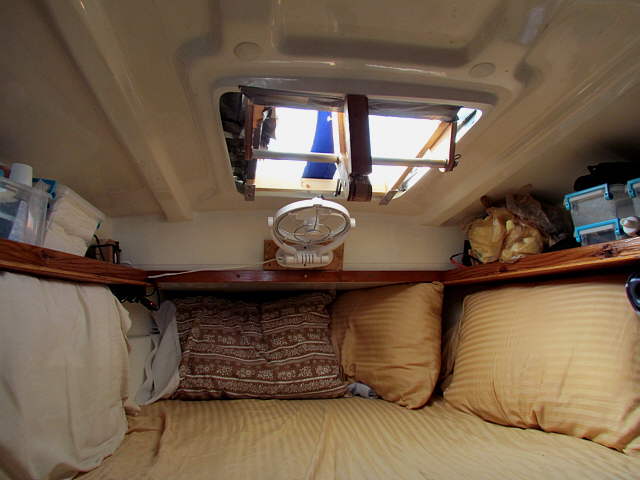
... easily fold it up out of the way.
Is the fan worth $100? In our mind it sure is and we are very happy with it. In fact so happy that we bought a second one from the West Marine store in Marathon when we made it further south to the keys. I mounted that one on a plywood base a little larger than the one above and put a 12 volt plug on it also. We use it up in the cabin during the day when we need some air and there is no wind blowing. We can set it about anywhere needed.
West Marine's number on the fan is Model #9835826 and it is a Caframo Sirocco Model 807 .
I realize that some of these might seem rather expensive when you can pick up a 12 volt fan at a truck stop for under $15. Believe me there is a difference as I have a couple of those. We figure that we are anchored out on the water for days at a time. No marine slip fees, no restaurant expenses, no motel or gas expenses. A fan like one of these is about the same as a couple nights in a slip or a night at a motel and we will have these for a lot longer than one night. Next time you are in a West Marine store check the fan out.
Now for the computer fan experiment....
..........................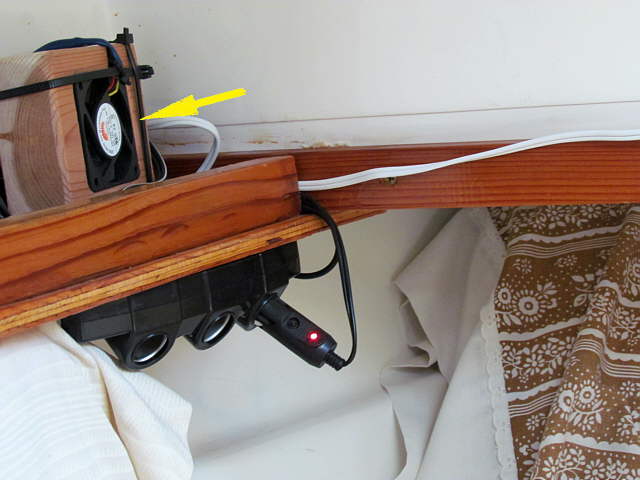
When I built the dedicated ship's low amperage 12 volt computer I ordered a couple computer fans to try out as I'd read where other sailor's had used these with some success. There is one above on the shelf where the V-berth fan plugs in. That one is on the shelf way back there, because it was declared pretty much useless.
..........................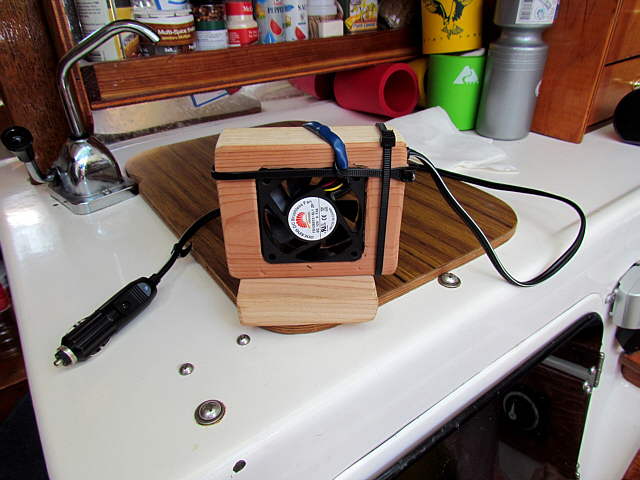
The one shown above was somewhat better I tried two different fans and the one above had a little more output. I took a piece of redwood and cut the center, actually milled it on the mill so that the fan body was a tight push-in fit and added a base. Pretty simple and straight forward. I then soldered on a wire with at 12 volt plug on the end to the fan wires. A couple plastic ties hold the cable in place at the soldered union.
..........................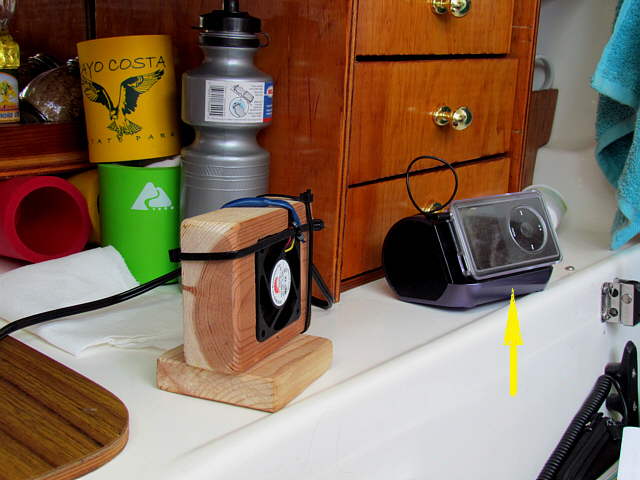
Ruth likes this little fan and usually has it on the sink counter pointed at her when needed. To the right of it is our favorite music maker. It is a cheap Walmart speaker, $20, that has amazingly good sound for the size and volume. It runs days on a couple AA batteries and we have a couple I-pods with all of our music from home. We like it as we can use it in the cabin, V-berth or cockpit and it works well in all places. We have larger speakers and a AM/FM Tape Deck that we hardly ever use.
..........................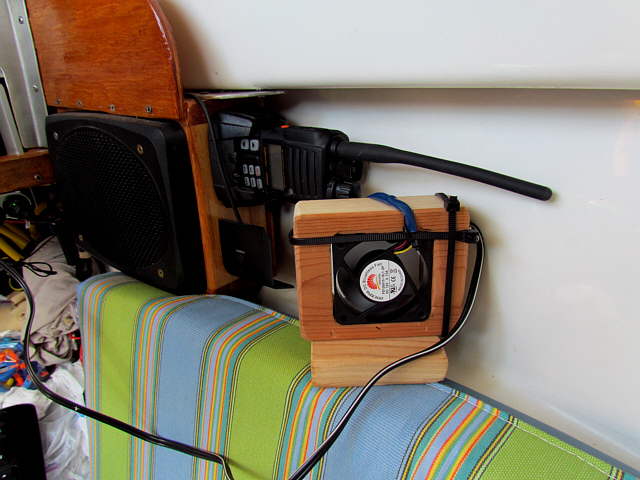
Here the little fan is sitting over on the port side just on top of the back cushion. In reality though this fan does not move a lot of air. You just feel a slight breeze on you. It is small and convenient to use though.
..........................
The big downer is that it uses .13 amps or 1.56 watts. About 2/3's the watts of the Caframo Sirocco Model 807 which uses 2.5 watts on low, but there is no comparison when it comes to how much air the Caframo fan moves compared to this little guy. It is like what is the difference in sailing in 20 mph of wind to 5 mph of wind. The Caframo wins by a huge margin.
The fan above was somewhat useful, Ruth likes it, but the other one in the picture further up the page moved so little air that it just got stored away and I'll cut the plug off and use it on another project. If you have one of these fans laying around try it, but I wouldn't put money into one. I did that for you.
Now how about cooling down with no fan. It is hard to imagine how great the following works until you try it. Of course you need a boat with a pop-top and a cover for the pop-top that opens in the front for this to work, but if you have that this really works well.
..........................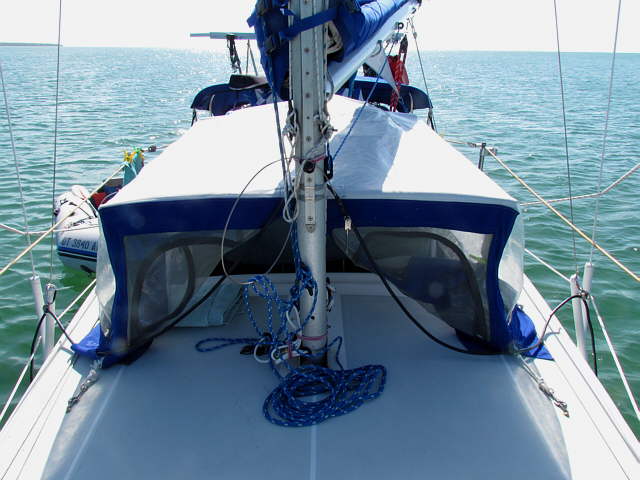
Normally the inside of the boat is hotter with a pop-top cover on, but if there is any wind at all and you are anchored and your boat points into it, which it should, the cover is your friend. Ruth put zippered windows in the front of ours which works great for getting some air in, but the fine netting that keeps the bugs out also restricts air flow. If there is wind then there probably isn't bugs, so unzip the front and fold it up inside...
..........................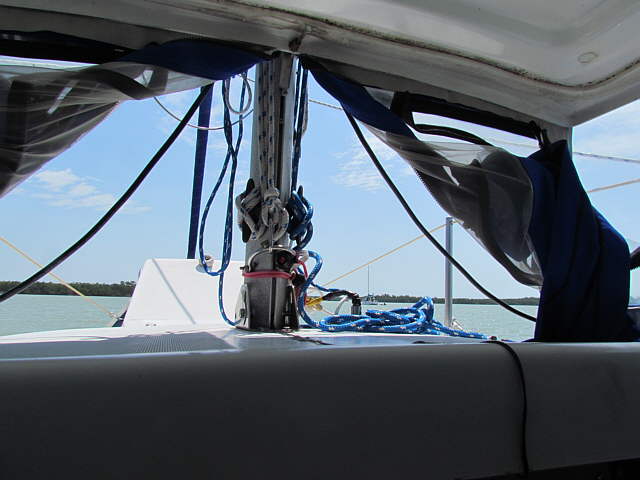
... and clamp it up with some of those cheap plastic clamps....
..........................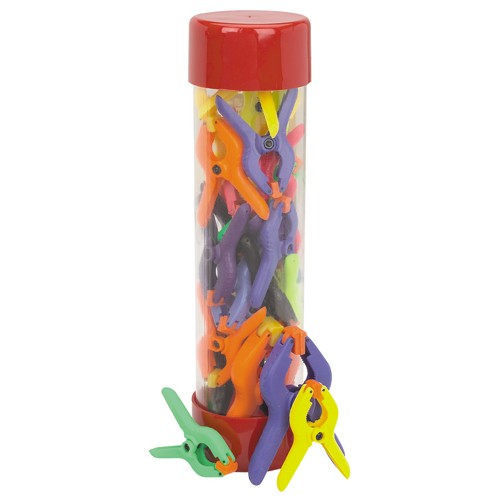
.... like the above $5 set that you can get from Harbor Freight or other stores. We use these lots of places, like
to dry cloths on the lifelines and such. They don't last forever, but are cheap.
..........................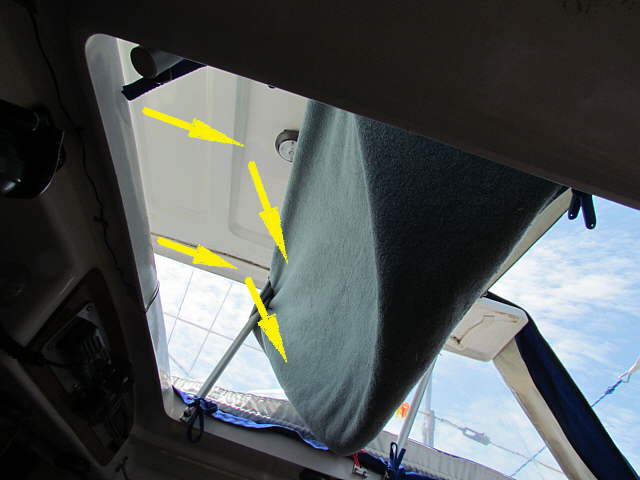
Next clamp a towel across the pop-top a little ways inside both at the top and the bottom. Without the towel the air just comes in the front and out the back. Sitting down you don't feel it. The towel redirects the air down and you will feel even a light breeze. You can't believe the difference. Having the cover on keeps the incoming air from spilling out the sides. If you had no cover you might be able to clamp towels on the sides of the pop-top and create the same effect.
..........................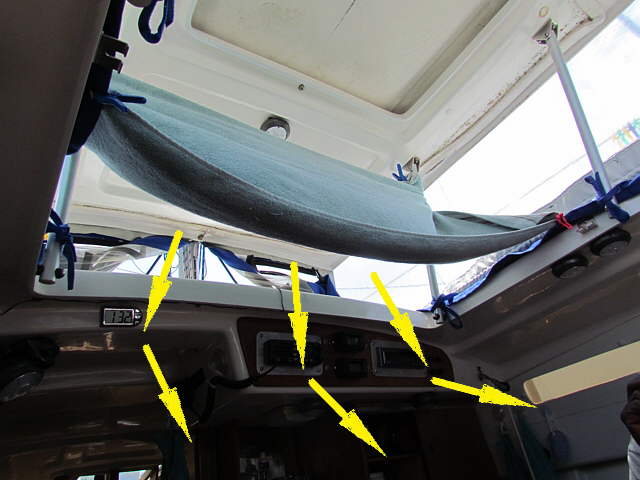
Here is another view of the towel. Nothing real tricky.
..........................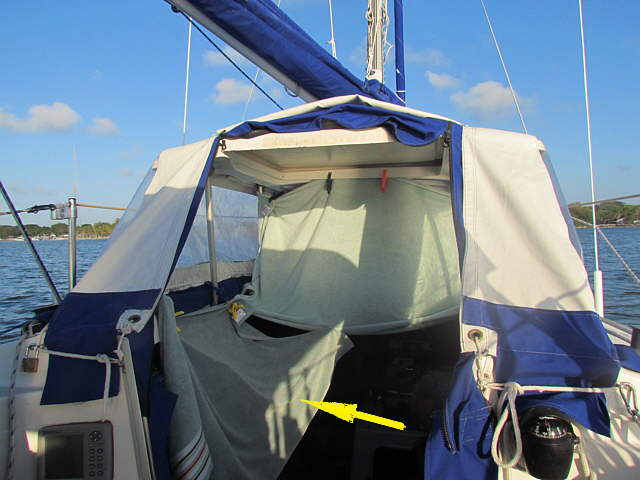
Here I added another towel to my side. It helps to direct some of the air on you, but mainly it was there to keep the sun off of me and out of my eyes as I was using the computer.
..........................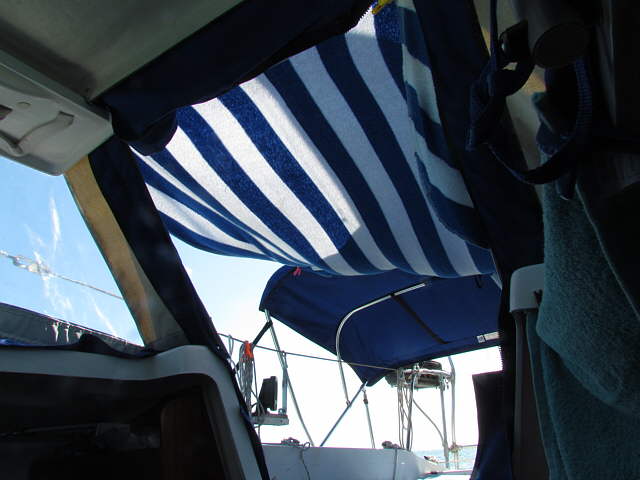
If the sun starts to come into the back of the cabin we will just clamp a longer beach towel...
..........................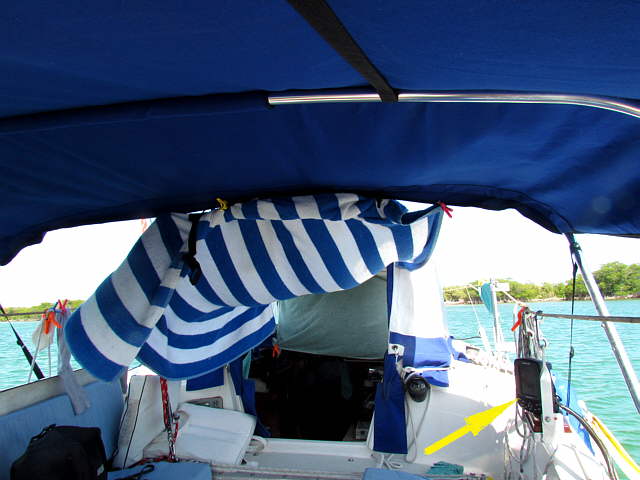
... to the front of the Bimini and the back of the pop-top cover. You can move this towel around depending on where the sun is. The arrow points to our GPS/Depth Finder, a Cuda 350 on mounted on the lifeline so that it can slide forward or aft for easy viewing.
..........................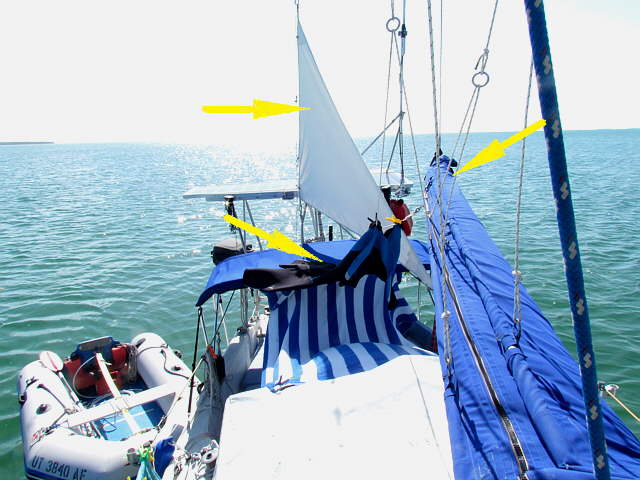
Here we are on anchor in the Florida Keys with the anchor sail, top arrow, up. One of my wet-suits drying, bottom left arrow, and the boom with the sailpack/cover held up with the topping lift and over to the side with the traveler and a preventer line. Nothing is much more relaxing that this!!